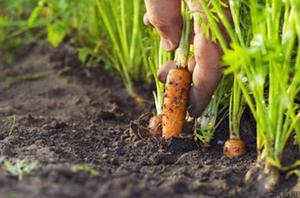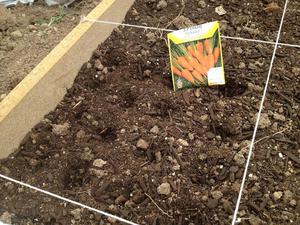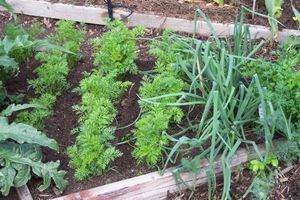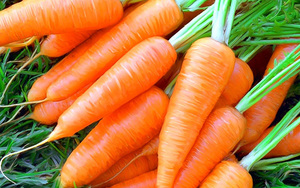 Carrots are among the irreplaceable vegetables on our table. This popular vegetable is used in many dishes. Each gardener annually grows carrots on his plot in order to harvest a good harvest in autumn. At this time, it is inexpensive, but closer to spring it begins to rise in price. Growing your own can save you money and eat a quality, delicious vegetable.
Carrots are among the irreplaceable vegetables on our table. This popular vegetable is used in many dishes. Each gardener annually grows carrots on his plot in order to harvest a good harvest in autumn. At this time, it is inexpensive, but closer to spring it begins to rise in price. Growing your own can save you money and eat a quality, delicious vegetable.
For experienced gardeners in planting carrots nothing complicated... They know many ways of planting this vegetable and they leave with the harvest every year. We will try to find out in more detail how to sow carrots and what you need to consider in order to collect healthy and tasty root vegetables from the garden.
Preparatory work before sowing
A healthy and tasty vegetable is very capricious, so getting a good harvest is not easy. Carrots can be sown three times throughout the year and then everyone must determine for themselves which of the planting options to choose:
- plant before winter;
- sow in early spring;
- plant in summer.
Soil for sowing seeds carrots must be moist. This will enable the seeds to use the moisture stored in the soil. When the ground is wet, the carrots will sprout quickly and there will be many shoots.
Before any sowing, it is necessary to prepare the beds. In loose soil, grooves are made with a distance of 18-20 cm from each other. Their depth should be about 5-6 cm. After that, the grooves need to be watered and rolled. The seeds are lowered evenly to a depth of about 1.5 cm, after which all the grooves are sprinkled with earth. It is desirable that the soil is more tightly adjacent to the seeds, this will give better contact with the soil and provide moisture access to the seeds. It is imperative to spray the garden bed with water, and also to mulch it with dry peat with a layer of 1 cm.
Covering material can be used to speed up the germination of seeds. Gardeners usually use translucent film, leaving gaps between the film and the bed about 5-6 cm. This method will allow the soil to not remain dry and will not allow a crust to form. After germination, the film is removed, otherwise the shoots will stretch.
How to plant carrots before winter?
 To get the earliest harvest of everyone's favorite vegetable, you need to sow seeds before winter. A piece of land protected from flooding by melt water is suitable for this. It is advisable that the bed is not blown by strong winds and it is clean of weeds.
To get the earliest harvest of everyone's favorite vegetable, you need to sow seeds before winter. A piece of land protected from flooding by melt water is suitable for this. It is advisable that the bed is not blown by strong winds and it is clean of weeds.
The selected plot of land is dug up to a depth of 20-25 cm, and humus is added if necessary. If the soil is dry, it should be well watered and the weeds removed when they appear. The grooves are made 4-5 cm deep and covered with a light layer of 1-1.5 cm of humus, peat or compost, all these components must be dry. If they are not there, you can take sand for this purpose. It is advisable to mulch the soil.
Seeds should always be sown dry and, in comparison with spring sowing, their number on average should be 25-30% more per unit of garden area.
For the entire cold period of time, the seeds will go through the stages of natural hardening. This will give them the opportunity to be resistant to spring frosts after germination. They will appear approximately 2 weeks earlier than after spring sowing. A carrot sown before winter will have a more developed root system, since the roots will feed on winter moisture. According to experts, winter root crops damage less pests. You can harvest collect 2-3 weeks earlierthan from spring sowing.
It is better to choose seeds for planting before the winter those that are more resistant to harsh weather conditions in winter. The resulting crop is not suitable for winter storage; it must be consumed before the onset of cold weather.
Care and watering of the beds
 The first time after seed germination, the beds need to loosen the soil, especially during the rainy season. Weeds must be removed throughout the entire growth period of the carrot. They also break through rows with root crops so that they do not grow too densely. The beds must be watered regularly and, if necessary, done fertilizing with fertilizers... All this work must be done in a timely manner in order to get a good harvest.
The first time after seed germination, the beds need to loosen the soil, especially during the rainy season. Weeds must be removed throughout the entire growth period of the carrot. They also break through rows with root crops so that they do not grow too densely. The beds must be watered regularly and, if necessary, done fertilizing with fertilizers... All this work must be done in a timely manner in order to get a good harvest.
As they grow, root crops become larger, they do not have enough space for normal development. If thinning is not done in time, the roots will be thin and crooked. To get strong and healthy roots, you need to leave the larger ones, and remove the weak ones. As soon as the height of the shoots reaches 5-7 cm, they begin to thin out in the rows. Usually this job is done twice and is best done during weeding. The distance between root crops should be at least 2-3 cm.
During thinning roots are covered with earthto avoid being attacked by pests such as carrot flies.
Carrots love moisture and timely watering is essential for a rich harvest. Proper watering increases the yield by 1.5 times, and also improves the taste of the vegetable. If there is not enough moisture, the carrots will be woody and tasteless. Optimal watering for a vegetable - once every 8-10 days, with a flow rate of 1 m2 6-8 liters of water. If carrots are too wet, this will lead to intensive growth of tops, and root crops will develop slowly.
If you over-pour a vegetable during extreme heat, the roots will crack. It is better not to fill them with water too intensively at once, but gradually moisten the soil until it is saturated in moderation. Ideally, the soil should soak in moisture to a depth of 12-15 cm... It is recommended to loosen the soil in the carrot garden before watering and then water it. The best irrigation method is to make shallow furrows between rows and fill them with water. Then sprinkle with loose earth. Watering should be stopped about 3 weeks before harvesting the vegetable.
Cold water has a bad effect on root crops, so it is better to use rainwater or the one that has stood in the sun in irrigation containers. Watering in the evening will be most beneficial.
Weeding and feeding
 The first weeding is performed when the seedlings are still small, about 2-3 cm. This must be done carefully, loosen only the aisle and be sure to eliminate weeds. If weeds are not removed in time, they will grow quickly and prevent the vegetable from developing. As a result, this will lead to the loss of half of the crop.
The first weeding is performed when the seedlings are still small, about 2-3 cm. This must be done carefully, loosen only the aisle and be sure to eliminate weeds. If weeds are not removed in time, they will grow quickly and prevent the vegetable from developing. As a result, this will lead to the loss of half of the crop.
If carrots grow on heavy soils, then on it after heavy rains a crust appears... It will impair gas exchange and seedlings will not be able to develop normally because of this. Timely weeding between rows will allow root crops to grow well. You need to loosen the soil with a depth of -4-5 cm, preferably in sunny weather, so that the weeds die faster. Loosening deeper can damage the root system.
When there are 3-4 leaves on the tops of carrots, it is worth feeding it. To do this, use:
- nitrogen fertilizers (urea);
- phosphoric;
- potash;
- bird droppings solution (for underdeveloped plants);
- mineral fertilizers.
All fertilizers are best applied when the soil is damp, so they are better absorbed. Experienced gardeners often use simple top dressing - weed infusion and wood ash... The finished composition is considered very effective and significantly increases the yield of carrots.
Growing juicy and tasty carrots is not difficult if you use the advice of experienced gardeners and work hard. A good harvest from your own garden will allow you to eat a healthy and vitamin-rich vegetable almost all year round.


